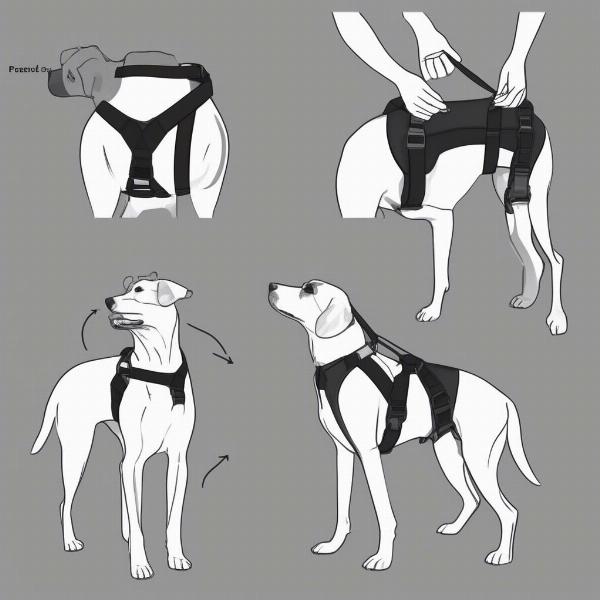A Y harness, also known as a front-clip harness, is a popular choice for dog owners seeking more control during walks. Unlike traditional harnesses that clip on the back, the Y harness features a leash attachment point at the dog’s chest. This design can be especially helpful for dogs who pull or lunge, as it gently redirects their forward momentum. Choosing the right Y harness involves considering your dog’s size, breed, activity level, and any specific training needs. This guide will delve into the benefits, drawbacks, and proper usage of Y harnesses, helping you decide if it’s the right fit for your canine companion.
Understanding the Benefits of Y Harnesses
Y harnesses offer several advantages over traditional back-clip harnesses and collars, particularly for dogs prone to pulling. When a dog pulls on a back-clip harness, it can engage their opposition reflex, encouraging them to pull even harder. The front-clip design of a Y harness helps avoid this issue by redirecting the dog’s attention back towards you. This can make walks more enjoyable for both dog and owner.
- Reduced Pulling: The front-clip design gently steers the dog sideways when they pull, discouraging the behavior.
- More Control: Provides better control, especially for strong or reactive dogs.
- Comfort: Distributes pressure more evenly across the chest and shoulders, reducing strain on the neck compared to collars.
- Safety: Reduces the risk of choking or tracheal damage that can occur with collars, particularly in brachycephalic breeds.
- Training Aid: Can be a useful tool in training loose-leash walking.
Choosing the Right Y Harness for Your Dog
Selecting the correct Y harness is crucial for both comfort and effectiveness. Consider these factors:
- Size: Measure your dog’s chest girth and neck circumference accurately to ensure a proper fit. Refer to the manufacturer’s size chart for guidance.
- Adjustability: Opt for a harness with multiple adjustment points for a customized fit.
- Material: Look for durable, breathable materials like nylon or neoprene.
- Padding: Padding on the chest and straps adds comfort, especially for extended walks.
- Hardware: Check for sturdy buckles and D-rings.
What Size Y Harness Does My Dog Need?
Measure your dog’s chest girth at the widest point, usually just behind the front legs. Also, measure the neck circumference where the collar typically sits. Compare these measurements to the manufacturer’s size chart. It’s better to err on the side of a slightly larger harness that can be adjusted down for a snug fit.
Are Y Harnesses Good for Puppies?
Yes, Y harnesses can be an excellent choice for puppies, as they help establish good leash manners early on and prevent pulling. Choose a lightweight, adjustable puppy-sized harness.
How to Properly Fit a Y Harness
A properly fitted Y harness should be snug but not restrictive. You should be able to fit two fingers comfortably between the harness and your dog’s body. The straps should not dig into the skin or restrict movement. The front clip should sit on the chest, not on the throat.
 Fitting a Y harness correctly
Fitting a Y harness correctly
Y Harnesses vs. Other Types of Harnesses
While Y harnesses are beneficial for many dogs, other harness types might be more suitable depending on your dog’s specific needs and activities. Back-clip harnesses are generally suitable for dogs who don’t pull excessively and offer more freedom of movement. gooby harness for dogs are known for their comfort and ease of use. Specialized harnesses like military harness for dogs or safety harness for dogs in the car cater to specific purposes.
Conclusion
Y harnesses are a valuable tool for dog owners seeking better control and reduced pulling during walks. By understanding the benefits, selecting the right size and type, and fitting it correctly, you can make walks a more positive experience for both you and your canine companion. Remember, a well-fitted Y harness, combined with consistent training, can contribute significantly to enjoyable and safe walks for years to come. Consider a vehicle safety harness for dogs or an army harness for dogs if you have specific needs.
FAQ
- Are Y harnesses good for small dogs? Yes, Y harnesses are suitable for dogs of all sizes, provided you choose the correct size.
- Can a Y harness stop a dog from pulling completely? While a Y harness can significantly reduce pulling, consistent training is essential for optimal results.
- How do I clean a Y harness? Most Y harnesses can be hand-washed or machine-washed on a gentle cycle. Follow the manufacturer’s instructions.
- Can I use a Y harness for running with my dog? Yes, many Y harnesses are suitable for running, but ensure it fits securely and doesn’t chafe.
- Are there any disadvantages to using a Y harness? Some dogs may initially try to paw at the harness or find it restrictive. Proper introduction and fit can usually alleviate these issues.
- How long does it take for a dog to get used to a Y harness? Most dogs adapt quickly, but some may require a few days or weeks of gradual introduction.
- Can I leave a Y harness on my dog all the time? It’s generally not recommended to leave a harness on a dog all the time, as it can cause matting or skin irritation.
ILM Dog is your trusted resource for expert advice on dog care and training. We offer a range of information on breeds, health, nutrition, behavior, and much more. Whether you’re a first-time dog owner or a seasoned pro, ILM Dog is here to support you every step of the way. Contact us today for all your dog-related queries! Email: [email protected]. Phone: +44 20-3965-8624.